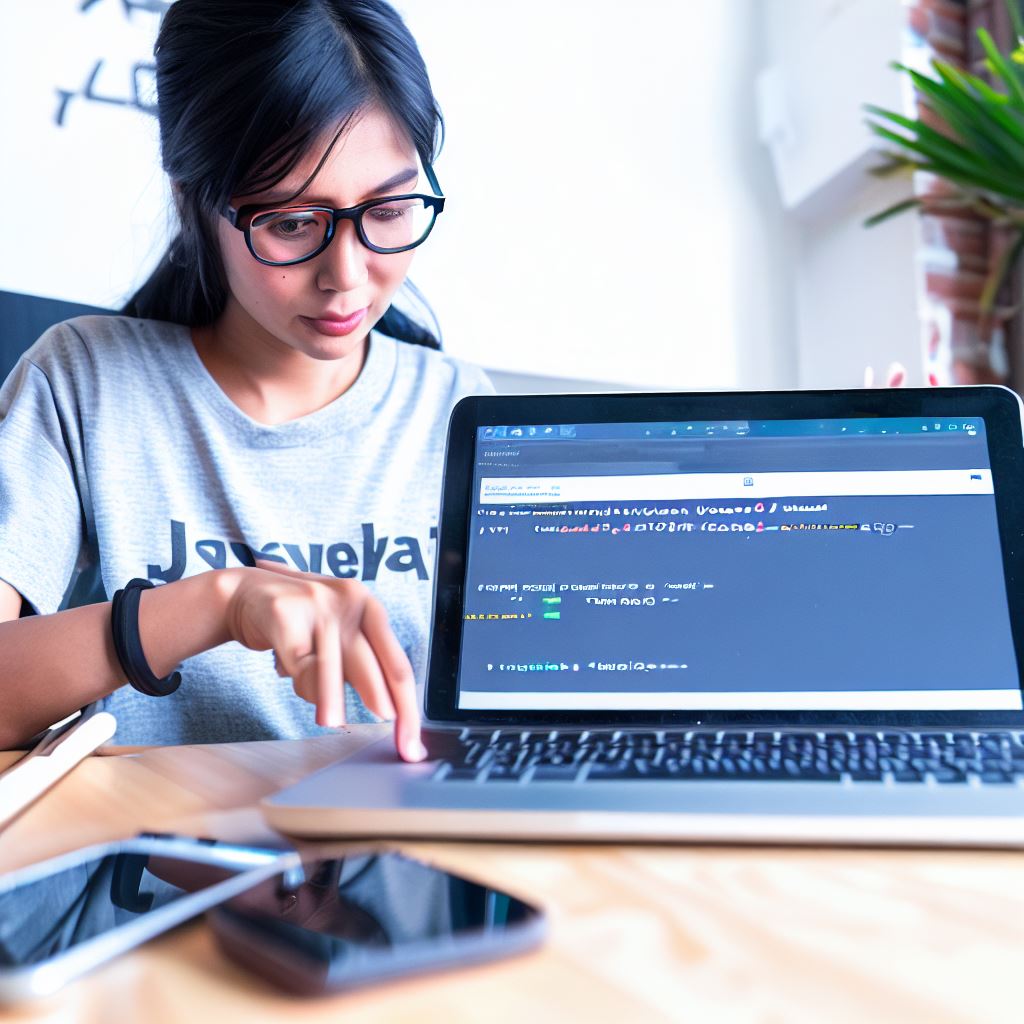Introduction
The role of coding apps in bridging gender gaps is a topic of great significance. Gender inequality in the field of coding needs to be addressed urgently.
In this blog section, we will discuss the importance of coding apps in promoting gender equality and provide an overview of the post.
Gender gaps in technology have been a persistent issue, with women being underrepresented in coding-related fields.
However, coding apps have emerged as powerful tools in bridging this gap.
Addressing gender inequality in coding is crucial because it ensures that women have equal opportunities to excel in the rapidly evolving tech industry.
These apps provide accessible platforms for women to learn coding skills and gain confidence in their abilities.
In this blog post, we will delve into the specific ways coding apps are empowering women.
By offering interactive and user-friendly interfaces, these apps make coding more engaging and less intimidating for beginners.
They also provide a supportive community where women can connect, collaborate, and seek guidance from fellow coders.
Definition of coding apps
What coding apps are and how they function.
Coding apps are digital platforms that teach individuals how to code and understand programming languages.
These apps provide interactive tutorials and exercises that help users grasp coding concepts and improve their skills.
Various coding languages that these apps can teach.
There are numerous coding languages that these apps can teach, including Python, Java, HTML, CSS, JavaScript, and more.
Each coding language has its own syntax and purpose, and coding apps help users understand and practice these languages.
User-friendly nature of coding apps, making them accessible to beginners
One of the key advantages of coding apps is their user-friendly nature, which makes them accessible to beginners.
These apps provide step-by-step instructions, visual aids, and real-time feedback to support users in their coding journey.
Beginners can start with basic coding concepts and gradually progress to more advanced topics through these apps.
Coding apps often use gamification techniques, turning coding lessons into interactive games, making learning more engaging and enjoyable.
With coding apps, users can learn at their own pace and in their own time, eliminating the barriers associated with traditional classroom learning.
Read: Ethical Guidelines in Medical Coding: Ensuring Accuracy
Gender disparity in coding
Coding is a field that has traditionally been dominated by men. Despite advancements in gender equality, there still exist significant gender gaps in the tech industry.
This section will present statistics and data highlighting the existing gender gaps in the field of coding.
Discuss the reasons behind the low representation of women in coding, and address some of the common stereotypes and misconceptions associated with women in coding.
Tech Consulting Tailored to Your Coding Journey
Get expert guidance in coding with a personalized consultation. Receive unique, actionable insights delivered in 1-3 business days.
Get StartedStatistics and Data on Gender Gaps in Coding
- In 2020, women accounted for only 25% of the computing workforce worldwide.
- Only 3% of female college students choose computer science as their major.
- Women hold only 14% of executive positions in the tech industry.
These statistics clearly highlight the significant gender gaps that exist in the field of coding.
The low representation of women raises concerns about diversity and the lack of equal opportunities.
Reasons Behind the Low Representation of Women in Coding
Several factors contribute to the low representation of women in coding.
- Lack of early exposure: Girls are often not introduced to coding at an early age, leading to a lack of interest and confidence in pursuing a coding career.
- Stereotypes and bias: Society often portrays coding as a male-dominated field, discouraging women from pursuing coding careers due to the fear of not fitting in.
- Work culture: Tech companies often have a male-dominated work culture, which can create an unwelcoming environment for women.
- Gender pay gap: Women in coding often face a gender pay gap, making the field less attractive and financially rewarding for them.
Addressing these challenges is crucial to bridge the gender gaps and create a more inclusive coding environment.
Stereotypes and Misconceptions Associated with Women in Coding
There are several common stereotypes and misconceptions associated with women in coding.
- Women are not as technically skilled as men: This stereotype overlooks the numerous skilled and talented women who excel in coding.
- Coding is not suited for women: This misconception limits the potential of women in the field and undermines their abilities and contributions.
- Women lack creativity in coding: Contrary to this belief, women bring unique perspectives and innovative ideas to the coding industry.
- Programming is a solitary activity: Coding involves teamwork and collaboration, and women excel in these areas as well.
Breaking these stereotypes and misconceptions is essential to encourage more women to pursue coding and bridge the gender gaps in the field.
The gender gaps in coding are clear and significant.
By highlighting the existing disparities, understanding the reasons behind the low representation of women, and addressing stereotypes and misconceptions.
We can work towards creating a more inclusive and diverse coding industry.
It is crucial to provide equal opportunities, encourage early exposure, and foster an inclusive work culture to bridge the gender gaps and ensure a more balanced representation of women in coding.
Read: A Day in the Life of a Certified Medical Coder
Benefits of Coding Apps in Bridging Gender Gaps
In today’s digital era, coding has become an essential skill that is highly sought after in various industries.
However, there exists a significant gender gap when it comes to coding education and participation.
Coding apps have emerged as a powerful tool in bridging this gap and empowering women to pursue careers in the tech industry.
In this blog section, we will explore the benefits of coding apps in bridging gender gaps.
Leveling the Playing Field in Coding Education
One of the key advantages of coding apps is their ability to level the playing field in coding education.
Traditional classroom settings often have a male-dominated environment, which can be intimidating for women.
Coding apps provide a platform where anyone, regardless of gender, can access the same learning resources and opportunities.
By using coding apps, women can learn coding skills at their own pace, without feeling rushed or left behind.
This empowers them to gain confidence in their abilities and tackle coding challenges without any insecurities.
Coding apps create an inclusive learning environment that encourages women to actively participate in coding education.
A Less Intimidating Learning Environment
Compared to traditional classroom settings, coding apps offer a less intimidating learning environment.
Women often face stereotype threat and unconscious bias in male-dominated fields like coding.
This can hinder their learning experience and discourage them from pursuing coding as a career.
Coding apps eliminate these barriers by providing a safe and supportive space for women to learn and practice coding.
They can explore coding concepts without fear of judgment or discrimination.
The interactive nature of coding apps allows women to experiment, make mistakes, and learn from them, fostering a growth mindset.
Flexibility and Convenience
Coding apps offer flexibility and convenience that traditional classroom settings cannot match.
Many women face multiple responsibilities, such as family obligations or full-time jobs, which can make attending regular coding classes challenging.
With coding apps, women can learn coding skills anytime, anywhere, and at their own convenience.
They can fit coding into their busy schedules without sacrificing their other commitments.
This flexibility significantly increases accessibility to coding education and allows women to develop their skills at a pace that suits them best.
Build Your Vision, Perfectly Tailored
Get a custom-built website or application that matches your vision and needs. Stand out from the crowd with a solution designed just for you—professional, scalable, and seamless.
Get StartedMoreover, coding apps often provide personalized learning experiences through adaptive algorithms.
These algorithms analyze the user’s progress and adapt the learning materials accordingly.
This ensures that women receive customized content based on their individual strengths and weaknesses, optimizing their learning outcomes.
Coding apps play a crucial role in bridging the gender gap in coding education.
By offering a level playing field, a less intimidating learning environment, and flexibility, coding apps empower women to develop their coding skills and pursue careers in the tech industry.
It is essential to continue promoting and supporting the use of coding apps to bridge the gender gaps and create a more inclusive and diverse field of coding professionals.
Read: Audits in Medical Coding: How to Be Prepared
Encouraging Female Participation through Coding Apps
When it comes to bridging gender gaps in the field of coding, coding apps have emerged as powerful tools.
Let’s explore the various initiatives and programs that promote coding to girls and women and showcase success stories of females who have started their coding journeys through these apps.
Additionally, we will highlight the positive impact of coding apps in building confidence and breaking down gender barriers.
Various initiatives and programs promoting coding to girls and women
- Girls Who Code: Girls Who Code is an organization that aims to close the gender gap in technology. They provide coding programs, clubs, and summer camps exclusively for girls, offering a supportive environment to learn coding skills.
- Technovation: Technovation challenges girls worldwide to develop an app that solves a real-world problem. Through Technovation’s curriculum and mentorship program, girls gain coding knowledge and build confidence in their abilities.
- Microsoft’s DigiGirlz: DigiGirlz is a global initiative by Microsoft that offers coding camps, workshops, and mentorship opportunities to inspire and empower young girls to pursue careers in technology.
- Coding Bootcamps for Women: Various coding bootcamps have been established specifically for women, such as Hackbright Academy and Ada Developers Academy. These bootcamps provide intensive coding training and job placement support.
Showcasing success stories of women who started their coding journeys through coding apps
- Sarah Stevenson, an aspiring programmer, began learning coding through an app called Codecademy. Today, she works as a software engineer at a leading technology company.
- Rachel Thompson, a high school student, discovered her passion for coding by using the SoloLearn app. She participated in coding competitions and won several accolades, earning her a scholarship to Stanford University.
- Marie Anderson, a mother of three, started learning coding using the Grasshopper app. She developed her skills and eventually launched her own application, which became an overnight success.
- Emily Roberts, a college student majoring in computer science, utilized the coding app Encode to enhance her understanding of programming concepts. This app helped her excel in her coursework and secure internships at top tech companies.
The positive impact of coding apps in building confidence and breaking down gender barriers
- Self-paced learning: Coding apps provide flexibility, allowing girls and women to learn at their own pace, boosting their confidence and encouraging them to explore coding without feeling overwhelmed.
- Accessible learning materials: Coding apps provide comprehensive learning materials, making coding education accessible to anyone with a smartphone or tablet. This convenience helps break down financial and geographic barriers.
- Supportive online communities: Many coding apps have built-in forums or communities where learners can ask questions, seek advice, and connect with like-minded individuals. This support system creates a sense of belonging and encourages continued learning.
- Gamification features: Coding apps often gamify the learning experience, integrating challenges, badges, and leaderboards. These features engage and motivate girls and women, making coding more enjoyable and rewarding.
- Celebrating diversity: Coding apps actively promote diversity by showcasing success stories of females in the field. By highlighting the achievements of women, coding apps challenge stereotypes and inspire other girls and women to pursue coding.
Coding apps play a crucial role in bridging gender gaps by encouraging female participation in coding.
Through initiatives, success stories, and the positive impact they have on building confidence and breaking down barriers, coding apps empower and inspire girls and women to embark on successful coding journeys.
Read: Audits in Medical Coding: How to Be Prepared

Delve into the Subject: Networking Basics: Interview Questions for DevOps
Challenges and Possible Solutions in Promoting Coding Apps to Women
When it comes to promoting coding apps to women, there are various challenges that need to be addressed.
However, by creating inclusive environments within coding apps, developers can enhance their platforms and better support women.
Let’s discuss these challenges and possible solutions.
Addressing the Challenges
1. Lack of Awareness
One of the significant challenges in promoting coding apps to women is the lack of awareness.
Many women are still unaware of the opportunities and benefits that coding can offer.
Solution:
Initiating targeted marketing campaigns and partnerships with educational institutions can raise awareness and reach out to women who might be interested in learning to code.
2. Stereotypes and Gender Bias
Stereotypes and gender bias often discourage women from pursuing coding as a career or hobby. These biases can make women feel unwelcome and increase the gender gap in the field.
Solution:
Encouraging diversity and actively debunking stereotypes within coding apps can create a more inclusive environment.
Mentoring programs specifically designed for women can also provide support and guidance.
3. Lack of Role Models
The absence of visible female role models in the coding industry can make it challenging for women to envision themselves as successful coders.
Solution:
Highlighting successful female coders and featuring their stories within coding apps can inspire and motivate women to pursue coding as a viable career option.
Optimize Your Profile, Get Noticed
Make your resume and LinkedIn stand out to employers with a profile that highlights your technical skills and project experience. Elevate your career with a polished and professional presence.
Get NoticedImportance of Creating Inclusive Environments
Creating inclusive environments within coding apps is crucial to attract and retain women. It is essential to foster a sense of belonging and create spaces where women feel comfortable and supported.
1. Encouraging Collaboration
Collaboration among app users can create a supportive community that facilitates learning and growth.
Solution:
Incorporating features like discussion forums, group projects, and mentorship programs within coding apps can encourage collaboration and facilitate interaction among users.
2. Offering Personalized Learning
Personalized learning experiences can cater to the diverse needs and learning styles of women who are using coding apps.
Solution:
Coding app developers can introduce adaptive learning algorithms that tailor the learning material based on individual progress and preferences.
Enhancing Coding Apps to Support Women
1. Promoting Skill Diversity
Coding apps should offer a wide range of coding languages and projects to appeal to women with different interests.
Solution:
Expanding the coding languages available on the platforms and including projects related to various fields like fashion, social impact, or health can make coding apps more appealing and relevant to women.
2. Addressing Bias in Algorithms
Unconscious bias in algorithms can perpetuate gender inequality by reflecting societal biases.
Solution:
Developers should test and review algorithms for fairness and work towards minimizing bias in the recommendations or results provided by coding apps.
3. Building Support Networks
Women often thrive in environments where they can connect with peers who share similar experiences.
Solution:
Introducing networking features within coding apps, such as online communities or mentorship matching, can help women build supportive networks and access guidance from other women in the field.
Promoting coding apps to women requires addressing challenges such as lack of awareness, stereotypes, and the absence of role models.
Creating inclusive environments and enhancing coding apps can not only attract more women but also provide the support they need to succeed.
By taking these steps, we can bridge the gender gap in coding and empower more women to pursue careers in technology.
Conclusion
In this blog post, we explored the topic of the role of coding apps in bridging gender gaps.
We discussed how these apps can empower women in the field of coding and help close the gender divide in the technology industry.
Coding apps provide accessible and interactive platforms that can encourage women to develop coding skills and pursue careers in tech.
They offer flexibility, convenience, and a supportive learning environment for women who may face barriers in traditional coding education.
By using coding apps, individuals can gain valuable skills like problem-solving, critical thinking, and creativity, which are essential in today’s digital world.
These apps also provide opportunities for networking, mentoring, and collaboration, enabling women to connect with like-minded individuals and professionals in the industry.
It is crucial to recognize the significance of coding apps in bridging gender gaps in the field of coding.
By encouraging readers to take advantage of these tools, we are promoting equal opportunities and breaking down the barriers that women face in the tech industry.
We must emphasize the transformative power of coding apps in empowering women.
By equipping themselves with coding skills, women can not only pursue fulfilling careers but also shape the future of technology.
To bridge the gender gap, it is essential that coding apps are accessible to women from diverse backgrounds and communities.




